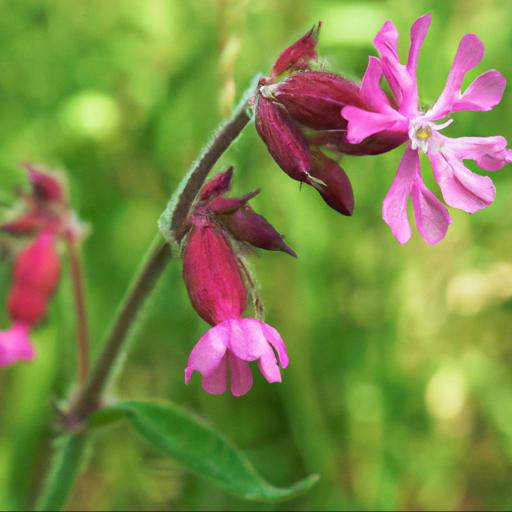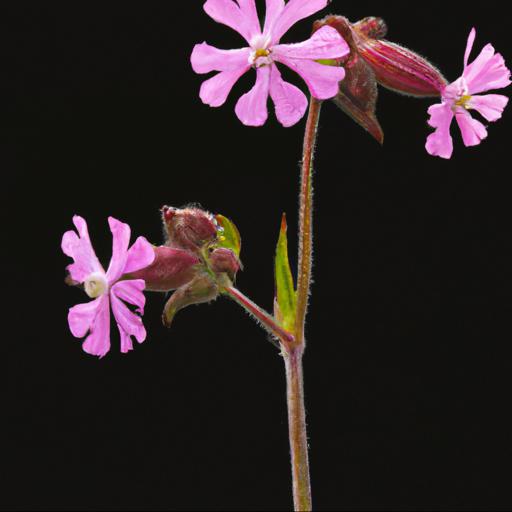Silene dioica, commonly known as red campion, is a flowering plant species native to Europe and parts of Asia. It is a member of the Caryophyllaceae family and is an important part of the British flora.
Red campion has a number of medicinal uses, particularly for treating skin conditions and wounds, and is also a popular ornamental plant. It has a wide range of habitats, from grasslands to woodlands, and is easily identifiable by its bright pink flowers with five petals. Red campion is an important source of nectar for bees, butterflies, and other pollinators, and is also a valuable food source for many species of birds.
Characteristics of silene dioica

Silene dioica, or commonly known as red campion, is a beautiful herbaceous plant that can be found in various parts of Europe and Asia. It has established itself as an important plant species in the UK, known for its attractive, distinctive flowers and its wide range of uses.
Red campion grows best on moist, well-drained soils in full sun or partial shade and reach heights of up to one foot. The flowers of Silene dioica are unique, with petals shaped a bit like a lantern. Each bloom consists of five petals with two distinct shades of red.
From afar, the flowers may look like a single color, but when examined up close, the petals reveal both a bright, fiery red that deepens near the center. Red campion also has two unique features – its exquisite scent and its relatively short blooming period.
Its scent is said to be a combination of tea and roses, making it highly desirable in gardens. Silene dioica is also a popular plant in herbal medicine. Studies have suggested the plant is rich in components like flavonoids and triterpenes, which may have antibiotic, anti-inflammatory and antimicrobial properties.
Its high flavonoid content is thought to have antioxidant, neurological and antidiabetic effects, which could potentially help with a range of conditions. Red campion is also a popular culinary herb, with its delicious flowers often used as a garnish or ingredient on salads and other dishes. When adding Silene dioica to the garden, gardeners should ensure the plant is not subjected to too much wind or hard frost.
Additionally, it should be sown in the late autumn and protected over the winter months with mulch. With the right care, red campion will reward the gardener with a spectacular flourish of colour and scent, making it a beautiful addition to any garden.
Benefits of silene dioica

Silene dioica, commonly known as catchfly, is an incredibly versatile and hardy flowering plant that can bring many benefits to any garden. As the name suggests, catchfly is a great choice for catching and attracting pollinators including hummingbirds, bees, and butterflies!
Not only does this flower bring these beauties to your garden, but it also improves the overall biodiversity of the area, meaning you’re helping Mother Nature in your own little corner of the world. The second major benefit of growing Silene dioica is its attractiveness to beneficial insects. The presence of these beneficial bugs helps keep harmful insect populations in check, and can help reduce the need for applying potentially toxic chemicals and pest control.
The flowers of the catchfly are also overflowing with nectar, drawing in beneficial predatory wasps and other insects looking for a snack. Finally, the blooms of the catchfly, with their delicate and wispy petals, can add a real touch of beauty to any garden. Whether they’re planted in mass, as a border, or a single patch, this flower can bring a vibrant shot of colour that’s both inviting and calming.
The foliage on the catchfly is also neat and tidy, so you don’t have to worry about it taking over the place. Given its many benefits, it’s no surprise why Silene dioica has become such a popular choice among gardeners.
Don’t miss out on the opportunity to bring this stunning flower to your garden today!
How to grow silene dioica

Growing Silene Dioica doesn’t have to be difficult! Most often known as red campion, Silene Dioica is an herbaceous perennial flowering plant native to Britain and Europe and can be found growing in hedgerows and on roadsides.
With relatively easy needs and beautiful magenta flowers, Silene Dioica is a great addition to any garden. In order to grow Silene Dioica, make sure to choose the right environment for it. You’ll want to plant your Silene Dioica in a sunny location with well-draining soil.
Plant your Silene Dioica in groups of 3 or more, at least 3 feet apart to give the plants enough space to grow. These plants will tolerate full sun or partial shade, as long as they get 6 to 8 hours of sunlight a day. Once your Silene Dioica is planted, water it regularly and keep it well-weeded.
For optimal growth, make sure to feed it a balanced fertilizer rich in phosphorous and potassium every two weeks during the growing season. You also want to make sure to deadhead the plants once the flowers start to fade to encourage continued flowering.
As with any plant, ensure you’re providing the right environment and proper care for your Silene Dioica to give it a chance to thrive! With their bright flowers and easy maintenance, these lovely plants are sure to attract amazing pollinators like bees and butterflies to your garden. Whether you’re just starting out with gardening or have been in the game for years, making the effort to add Silene Dioica to your garden is sure to bring an additional level of tranquility and beauty to your outdoor space.
Common uses of silene dioica
Silene dioica, commonly referred to as Catchfly, is one of the most popular and versatile plants in the UK garden. A perennial species of flowering plant, this vibrant flower goes by many alternative names, as well, including Clary Catchfly, Campion, and Redstem Catchfly. It is highly sought after by both amateur and professional gardeners alike, and rightfully so, given its beauty and many useful practical benefits.
When in bloom, this colorful, daisy-like flower bursts into life. Its small and delicate petals can range in hue from pale yellow to deep and bright red, while its slim, jagged foliage creates a sharp contrast to its soft and inviting petals.
Silene dioica is a great addition to any garden, drawing in vibrant and colorful butterflies, moths, and more. In addition to its striking visual aesthetic, Silene dioica is also highly practical. Its extended blooming window helps to ensure that its unique color remains in your garden for greater periods of time.
This can be especially beneficial for beginner gardeners, as it reduces the amount of work required to keep their outdoor space looking beautiful. Moreover, Catchfly can help to keep nasty pests at bay.
Its smooth, sticky leaves furnish this plant with an effective defense against insects and other critters that would otherwise happily chow down on it. Thus, those looking to spruce up their garden whilst also keeping pests away should consider planting some Silene dioica. Overall, Silene dioica is undoubtedly one of the best picks for UK gardeners.
Its vibrant aesthetics, long blooming window, and ability to ward off pesky critters makes it a great choice for those looking to bring a splash of color and improved ecological balance to their garden.
Bottom Line
Silene dioica, commonly known as red campion, is an herbaceous perennial plant native to Europe, North Africa, and parts of Asia. This species is a popular garden plant, valued for its showy pink or white flowers and its ability to attract pollinators. Red campion is a low-maintenance plant that can thrive in a variety of conditions, and it is a great choice for any garden.
It is also a valuable food source for many species of wildlife.
FAQ
What is the scientific name of Silene dioica?
The scientific name of Silene dioica is Lychnis dioica.
What are the common names of Silene dioica?
Common names of Silene dioica include red campion, white campion, and bladder campion.
What are the characteristics of Silene dioica?
Silene dioica is an annual or biennial flowering plant in the family Caryophyllaceae. It is native to Europe, North Africa, and parts of Asia. It has a basal rosette of leaves and a stem with a single flower. The flowers are white or pink, with five petals and ten stamens. The fruit is a capsule containing many small seeds. It prefers moist, well-drained soils and full sun.
Where is Silene dioica found?
Silene dioica is found in Europe, North Africa, and parts of Asia.
What is the habitat of Silene dioica?
Silene dioica is a species of flowering plant found in meadows, grasslands, and open woodlands in temperate regions of Europe, North Africa, and Asia.
What are the uses of Silene dioica?
Silene dioica, also known as red campion, is a flowering plant that is used for medicinal purposes, as an ornamental plant, and as a source of food for wildlife. It has been used to treat respiratory ailments, skin conditions, and digestive problems. It is also used as a soil stabilizer and to reduce erosion.

